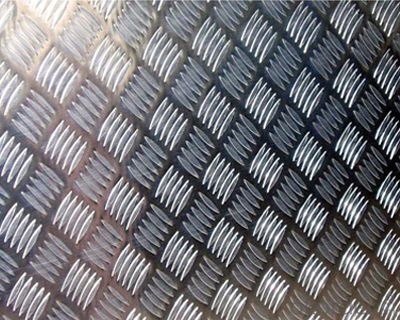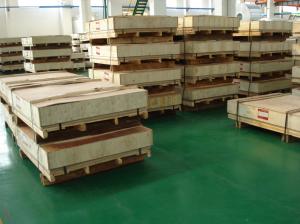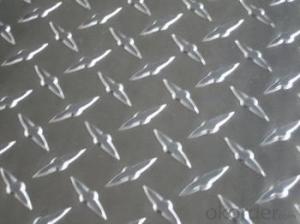4x4 Aluminum Diamond Plate Sheets - Embossed Aluminum Sheets for Different Usages
- Loading Port:
- Shanghai
- Payment Terms:
- TT or LC
- Min Order Qty:
- 5 m.t.
- Supply Capability:
- 100000 m.t./month
OKorder Service Pledge
OKorder Financial Service
You Might Also Like
1.Structure of Embossed Aluminum Sheets for Different Usages
Our Embossed Aluminum Sheets for Different Usages have different patterns including diamond, stucco, big five bars, small five bars, etc.
Embossed Aluminum Sheets for Different Usages are widely used in decorative purchase in construction, packing and appliance. They are also very popularly used in anti-slippery purchase in vehicles and public places.
2.Main Features of Embossed Aluminum Sheets for Different Usages
•High intensity
•Easy to be processed and shaped
•Weather resistance
•Anti-pollution & environment protection
3. Embossed Aluminum Sheets for Different Usages Images


4.Specification of Embossed Aluminum Sheets for Different Usages
Alloy: AA1050, AA1060, AA1070, AA1100, AA3003, AA3004, AA3005, AA3105, AA5052
Temper: H14, H18, H24, H26, H32
Thickness: 0.2-20mm
Width:10mm- 1500mm
Standard: GB/T3880-2006, ASTM, ISO, EU standard
5. FAQ
A.What about inspections to guarantee quality?
For each order for Aluminum Sheets, we will arrange strict inspection for raw materials, inspection during production and inspection for finished goods.
With requirement of customers, we also can arrange the third party inspection.
B.What about delivery?
We will put order for Aluminum Sheets in production schedule after order gets confirmed against copy of TT or L/C. Normally it takes about one month for production. Exact shipment schedule is different based on different sizes and quantity.
C.What is the MOQ?
5 tons for each size.
D. Where have you exported aluminium sheets?
We have exported aluminum sheets to many countries. Main markets include South East Asia, Middle East, North America, South America, etc.
- Q: Is it possible to utilize recycled aluminum to manufacture new items?
- <p>Yes, recycled aluminum can be used to create new products. Aluminum is highly recyclable, and the process of recycling it requires significantly less energy compared to producing aluminum from raw materials. Recycled aluminum maintains the same properties as new aluminum, making it suitable for a wide range of applications, from packaging to construction materials. The use of recycled aluminum helps reduce waste, conserve resources, and lower environmental impact.</p>
- Q: Is it possible to utilize aluminum sheets in the construction of high-rise buildings?
- <p>Yes, aluminum sheets can be used in high-rise buildings. They are valued for their lightweight, high strength, and resistance to corrosion. Aluminum is often used in curtain walls, window frames, and roofing due to its durability and recyclability. It also offers design flexibility and can be easily shaped and joined, making it suitable for modern architectural designs. However, it's important to ensure that the aluminum used meets the specific building codes and safety standards for high-rise construction.</p>
- Q: Can aluminum sheets be used in aerospace applications?
- Yes, aluminum sheets can be used in aerospace applications. Aluminum is a widely used material in the aerospace industry due to its excellent combination of strength, lightweight properties, and resistance to corrosion. It is used in various components of aircraft, such as the fuselage, wings, and structural panels, where weight reduction is critical for fuel efficiency and performance. Additionally, aluminum sheets can be easily fabricated and formed into complex shapes, making them suitable for various manufacturing processes in the aerospace industry.
- Q: I have a specific design I'd like to cut out of thin sheet metal (aluminum or tin) and I'm wondering how to make it more sturdy. The sheet metal is a bit flimsy. Can I strengthen it by heating it up (butane torch) and cooling it quickly?
- This Site Might Help You. RE: Can you temper aluminum or tin? I have a specific design I'd like to cut out of thin sheet metal (aluminum or tin) and I'm wondering how to make it more sturdy. The sheet metal is a bit flimsy. Can I strengthen it by heating it up (butane torch) and cooling it quickly?
- Q: This question asks for a list of various adhesive types that are suitable for bonding aluminum sheets together.
- <p>There are several types of adhesives used for bonding aluminum sheets, including epoxy adhesives, which are strong and resistant to heat and chemicals; acrylic adhesives, known for their flexibility and UV resistance; cyanoacrylate or super glue, which offers fast bonding; polyurethane adhesives, providing excellent adhesion and durability; and silicone adhesives, which are great for high-temperature applications. Each type has its specific properties and applications, making them suitable for different bonding requirements and environmental conditions.</p>
- Q: Bauxite ore contains aluminum oxide, which is decomposed using electricity to produce aluminum metal and oxygen. What mass of aluminum metal can be produced from 125 g of aluminum oxide?I'm really confused and I need help. Thanks.
- Safely Permanently Remove Moles, Warts and Skin Blemishes
- Q: What are the different methods of surface treatment for adhesive bonding of aluminum sheet?
- There are several different methods of surface treatment for adhesive bonding of aluminum sheet. These methods can help improve the bond strength and durability of the adhesive joint. Some common methods include: 1. Mechanical Surface Treatment: This method involves roughening the aluminum surface using techniques such as sandblasting, abrasion, or wire brushing. The roughened surface creates a better mechanical interlock between the adhesive and the aluminum, increasing the bond strength. 2. Chemical Surface Treatment: Chemical treatments can be used to remove contaminants, oxidation, or corrosion from the aluminum surface. Common chemical treatments include acid etching, chromate conversion coating, or anodizing. These treatments improve the surface cleanliness and promote adhesion by creating a chemically reactive surface for the adhesive. 3. Plasma Treatment: Plasma treatment involves exposing the aluminum surface to a low-temperature plasma discharge. This process modifies the surface energy and removes contaminants, thereby enhancing the wettability and adhesion of the adhesive. 4. Primer Coating: Applying a primer coat on the aluminum surface can improve adhesion by promoting chemical bonding between the adhesive and the substrate. Primers are typically designed to promote adhesion to specific substrates and can enhance the bond strength and durability of the adhesive joint. 5. Surface Activation: Surface activation techniques, such as flame treatment or corona treatment, can be used to increase the surface energy of the aluminum sheet. These methods create free radicals on the surface, which improve the bonding characteristics of the adhesive. It's important to note that the selection of the surface treatment method depends on various factors like the specific adhesive used, the desired bond strength, the application requirements, and the condition of the aluminum surface. Therefore, it is recommended to consult adhesive manufacturers or experts to determine the most suitable surface treatment method for a specific adhesive bonding application.
- Q: Can aluminum sheets be used together with other materials, specifically insulation materials?
- <p>Yes, aluminum sheets can be used in combination with other materials, including insulation materials. Aluminum is often used as a cladding material due to its durability and resistance to corrosion. When combined with insulation materials, it can enhance the thermal performance of a structure by reducing heat transfer. This combination is common in construction and roofing applications, where aluminum sheets can provide a protective outer layer while the insulation material manages thermal control. The use of aluminum with insulation materials can lead to energy-efficient buildings and improved indoor comfort.</p>
- Q: What are the distinctions among various grades of aluminum sheets?
- <p>Yes, there are differences between different grades of aluminum sheets. These differences are primarily based on the alloy composition, which affects properties such as strength, formability, and corrosion resistance. For instance, 1000 series aluminum is pure and soft, making it ideal for general purposes. 2000 series is harder and stronger, often used in aerospace applications. 3000 series is known for its high resistance to corrosion and is used in marine applications. 5000 series offers good strength-to-weight ratio and is used in structural applications. 6000 series is known for its strength and is used in construction and industrial applications. Each grade has specific uses based on its unique characteristics.</p>
Send your message to us
4x4 Aluminum Diamond Plate Sheets - Embossed Aluminum Sheets for Different Usages
- Loading Port:
- Shanghai
- Payment Terms:
- TT or LC
- Min Order Qty:
- 5 m.t.
- Supply Capability:
- 100000 m.t./month
OKorder Service Pledge
OKorder Financial Service
Similar products
Hot products
Hot Searches
Related keywords




























